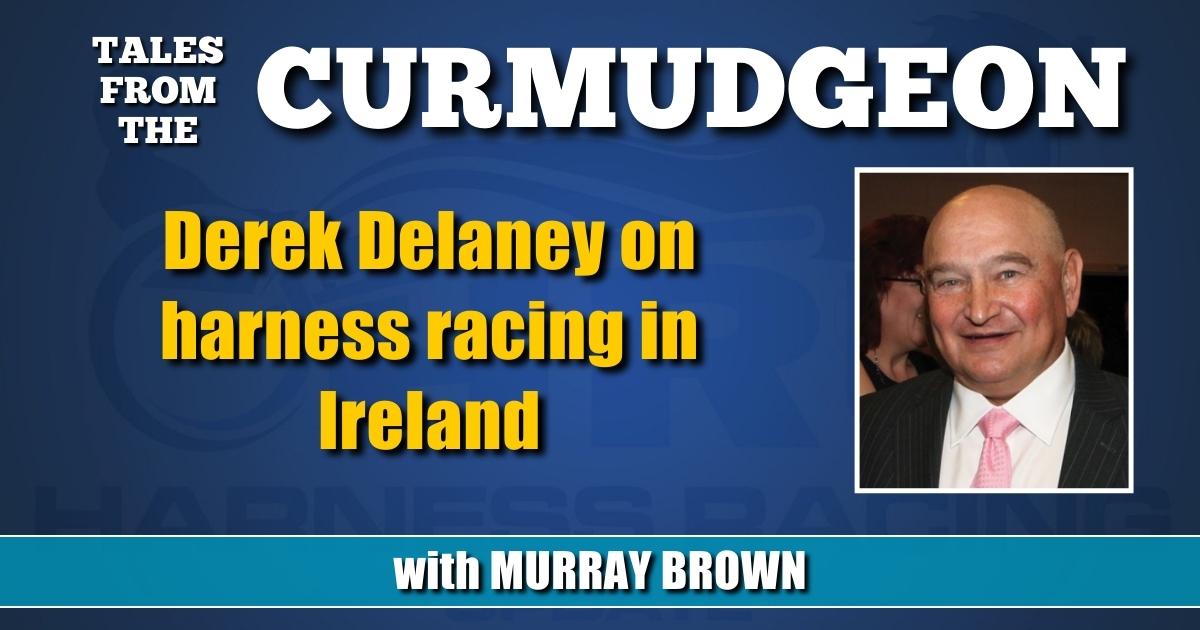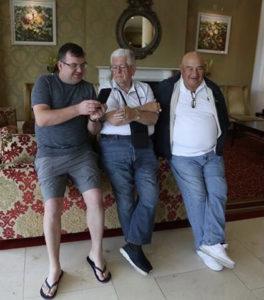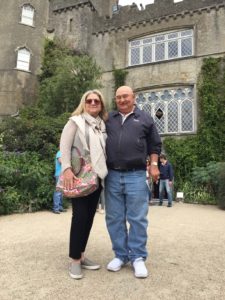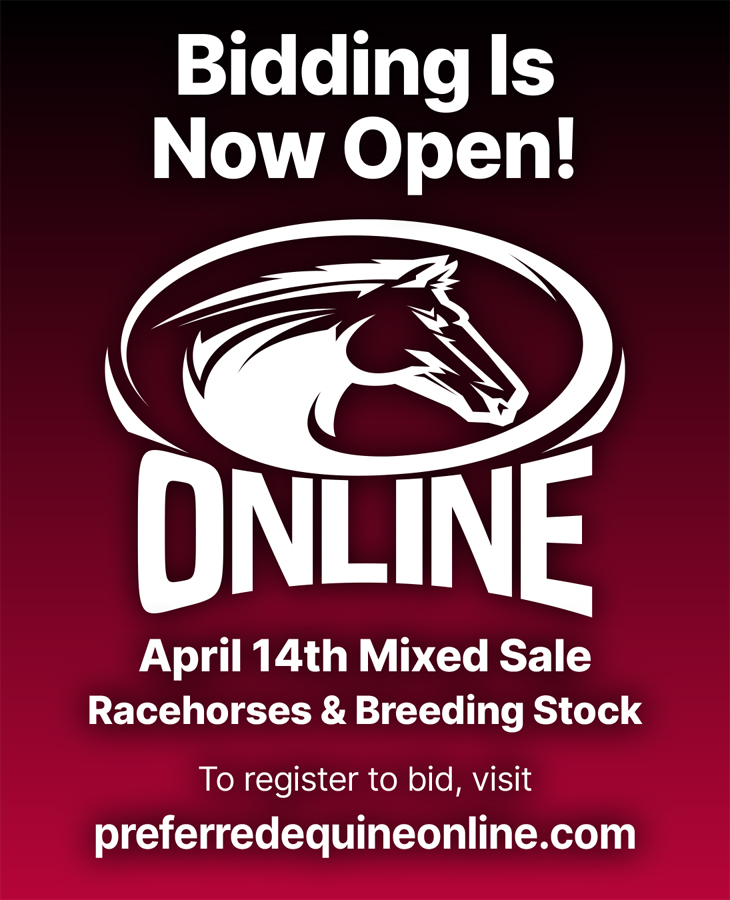Derek Delaney on harness racing in Ireland
A conversation with the man that has brought the harness racing world to Ireland for the Vincent Delaney Memorial.
by Murray Brown
I have been fortunate to have attended harness racing events literally all over the world. I’ve experienced the premier events in France, Sweden, Italy and been to races in New Zealand and Australia in addition to all the great races in Canada and the United States.
Nowhere have I had as much pure fun and enjoyed a more welcoming atmosphere than in Ireland, while attending the Vincent Delaney Memorial (VDM) in Portmarnock Raceway, a small half-mile track about a half-hour drive from Ireland’s capital, Dublin.
Before first attending the VDM, I had been vaguely aware of the existence of harness racing in Ireland where the tradition of raising and racing great thoroughbreds reigns supreme.
That is still pretty much the case.
However, in recent years, thanks, in part, to the efforts of brothers James and Derek Delaney, harness racing has made some progress.
There is now a growing breeding and racing community within the country.
I was first invited to come to the Vincent Delaney Memorial Racing Festival in 2016. I had never before been to Ireland. I said to myself that would probably be a lot of fun.
Little did I know how much fun and how enjoyable it would turn out to be.
I arrived at the Dublin Airport and took the courtesy bus to the nearby Hilton Airport hotel. From that time forward I was the guest of the wonderful Delaney family.
I first met Derek, his wife Lillian and their then 8-year-old daughter Lexie. I also met his wonderful assistant, the late Bernie Kelly.
We were treated like kings, as have been most guests who have come from all over the world to take part in this wonderful event.
It’s not as though the purses are even slightly comparable to the best throughout the world. It has none of the majesty of the Prix d’Amerique or the Elitloppet. But this guy would say that neither of them — or any other harness event — has the fun and good feeling that is found with the Irish, especially the Irish and their love of the horse and great fun. Can there be a better combination?
Where else would you have a pint of Guinness with your breakfast instead of, or in addition to, your morning coffee?
Where else would the guests take a ride through downtown Dublin in a row of carriages each behind a team of Friesan horses, one driven by no less a personage than Roger Huston?
Where else at the conclusion of a day’s racing would nobody leave the racetrack, because all the fun was just starting. Virtually all the fans and horsemen remain for the socializing which follows for hours after the racing takes place.
Where else between races can you be entertained by a pair of talented young girls performing Irish Dance or by a magician performing his tricks?
Where else do you do your wagering with a bookmaker at the track and indulge with cheerful repartee with him?
There is nothing quite like it and this guy is lucky to have experienced it for three consecutive years.
I recently had a conversation with Derek Delaney one of the two brothers who have been major factors in the sport’s renaissance.
Tell me about yourself and your upbringing. What do you do in the real world apart from the horse business? What can you tell me about your family — your wife and your daughter?
“I am 45 years old I was born on the north side of Dublin in a place called Ballymun. It is a working class area that was made up of a lot of high rise flats at the time a project that was built to solve the housing crisis back in the ‘70s. The flats have since been demolished. I lived there with my mother and father and my older brother James until I was around 4 years old then we moved to a house in Tallaght, another working class area on the Southside of Dublin just at the foothill of the Dublin Mountains. I think this is probably where myself and my brother James fell in love with horses. At that time there was a lot of travellers, i.e. gypsies, living nearby and they used to let their horses roam around the open green spaces in the area. We just loved them. I suppose you could say it was like living on our own horse farm. We would feed them, ride them bare back around the streets as if we owned them. It was a bit like the wild west.
“When I was 10 we moved back to the North side of Dublin to another working class area called Coolock to be closer to my Mam’s family. We continued our love for the horses and myself and James started to raise money to purchase one. We mowed lawns and chopped sticks and firewood and did any other work that would help us to purchase our very first horse. We had the money saved in a jar in the attic of our new house to make sure nobody could steal our dream. We saved £78 and went to the Smithfield horse fair in Dublin City Centre and purchased our first horse, a black and white pinto foal that was our first ownership/partnership. We continued working evenings after school and on the weekends, holidays etc. and eventually up scaled to working horses to pull 4-wheel carts that we used to sell coal and firewood in the winter and collect scrap metal in the summer.
“I was around 13 years old at this stage, I hadn’t much of an education growing up. I never really liked school and I knew how to make money for myself so thought it was pointless. So, I never finished any secondary level education which sometimes I do regret. But as someone said to me before, there are some things that just can’t be learned out of a book. Me and James have nearly always worked for ourselves since we were kids with various different business interests including motor trade, transport, bars, restaurants and some property interest. We put a lot of our time into running the horse business now Oakwood Stud. All my family have relocated from Dublin to Rhode, Co. Offaly approximately one hour from Dublin. James lives on the main farm Oakwood Stud and I recently built a new home on my farm which is approximately 1.5 miles from his. We are basically living the dream.
“I am married to Lillian, we have one daughter, Lexie, who is 13 now. Me and Lillian met locally when I was just 16 and she has put up with me ever since. I don’t know how, but she has. She is an outstanding mother to our daughter and encourages her in everything that she wants to do including a lot of charity work to help the homeless over the years. Lexie has done multiple fundraising events. She gained recognition for it and has been nominated for major awards for her efforts. The most memorable one that she won was The Woman’s Way Young Fundraiser Of The Year back in 2019. I am really proud of her achievements. Lillian is definitely the driving force and the backbone of our little family.
You were three brothers. James is the oldest, then you and then Vincent.
“Yes, that is right. James is the eldest. He is three years older than me and Vincent was seven years younger than me.”
How and when did you become involved with harness horses and harness racing?
“I became interested when I was around 12. The Wallace family have a training centre near our home in Dublin and they used to jog horses on the road by our house. We used to go up around the stable yard as kids and down to the local track in Portmarnock. That’s probably when the bug bit us. But it wasn’t until years later that we actually purchased a pacing horse to race on the track. That was back in 2000 and it just snowballed from there.”
Who motivated you to start a breeding farm in Ireland?
“I suppose you could say we motivated ourselves. We have always had a keen interest in breeding horses since we were kids. So it was natural for us to breed some mares when we got involved in harness racing. We always followed the U.S. bloodlines and tried to improve our standards. In 2003, we had the opportunity to breed to some better class of stallions when Alan Galloway from Alabar Farms Australia shipped some frozen semen over to the UK and Ireland from Village Jasper, Safely Kept and Armbro Operative. We bred to all three stallions. We bred a really good racehorse, a grey gelding called Oakwood Outlaw. He was out of a Laag mare. Anyway, long story short, the mare had not produced anything before or since. We quickly realized this was the way forward, but the semen became discontinued so we just plodded on racing and breeding an odd mare to whatever stallions were available at the time and having some fun, with the breeding always in the back of our mind.”
How did the Vincent Delaney Memorial come about?
“We began the Vincent Delaney Memorial when our younger brother Vincent passed away suddenly in 2011 at the age of 27 from a heart attack while in the local bookmakers. We were approached that year to have a memorial race for him at the track in Portmarnock. But it was a bit too soon to be honest. It was a massive shock to our family at the time and we just weren’t up for it that year. A lot of the memorial races over here just come and go so to speak. We wanted to try do something that would not only help us to remember Vincent every year, but that was going to benefit the sport in some way. We came up with the idea of a 2-year-old race to help stimulate the breeding aspect side of the sport. I spoke with the late Bernie Kelly, and told her the plan. She agreed to help us get it off the ground. We formed a small committee made up of family and friends and got Bernie Kelly involved for her expertise in the administrative side of racing. At the time, there weren’t any regular 2-year-old races in Ireland. So we figured if we got enough sponsorship and stakes money we could advertise the race to be the richest purse ever for 2-year-olds in Ireland and the UK. Ironically we had a High Street bookmaker, Ladbrokes, sponsor the inaugural running of the event with the help of my cousin, Denise Moore, who works for the company. This gave the race great creditability from the off. We had 29 horses nominate the first year and we raced one straight mixed sex final for a purse of €10,000 as advertised. When word got out about the prize money on offer it just grew from there with nominations increasing year after year. We kept having mixed sex races up until 2016 when Adam Bowden of Diamond Creek Farm agreed to support a fillies division. We are most grateful for the support by Hanover Shoe Farms in sponsoring the VDM and of Diamond Creek Farms in sponsoring its filly division. The number of overall horses nominated jumped from 59 the previous year to 78. We also added 3-year-old, 4-year-old and other feature races to the card. Along the way, we promoted as much as we possibly could and kept thinking of ways to promote the race.
“In 2014, we asked Roger Huston to come and call the races. He is very well known over here for his commentary on the Jug. He immediately reached out and said he would love to come and call the race and has done so every year since. Wally Hennessey was also asked to attend that year to drive and that brought a lot of attention from the USA. Heather Vitale came over for that and Anthony Butt from New Zealand came as well. We also had Bill Hutchinson visit from Australia. That was the year I believe Vincent’s race really took off around the globe. We won the best news article at the World Trotting Conference in Sydney that year for a piece that was written by Aisling Crowe for The Irish Independent Newspaper. Steve Wolf and his wife were also in attendance. He helped us a lot with press releases and with making connections with people in the U.S.
“Everything just snowballed from there. I am also very pleased with how this year’s 10th year anniversary VDM event went at Tir Prince Raceway in North Wales. They broke all records for attendance, streaming purchases, bar and food sales at the track — even with the COVID restrictions that were in place on travel. We also raced for the richest purses to date for the anniversary meeting through fundraising, nomination fees and sponsorship. The figures actually doubled across the board from the last meeting held in 2019 the VDM 2YO finals raced £27,600 a division that equates to €65,000 euros overall that’s a 650 per cent increase from the first event held back in 2012. I think it is fair to say it is the race that everyone wants to win.”
Did you start racing before breeding or breeding before racing? Do you race any yourself now?
“We raced before we bred. We had horses with public trainers. Then James took out a trainers’ licence and trained all of ours at home. We had some good success over the years. James stopped training in 2015 and we start focusing more on the breeding side of things. We thought it was best to concentrate on one rather than spread ourselves thin on both.”
With the relatively small purses and yearling prices is it possible to make a profit breeding horses in Ireland? Is it entirely a hobby?
“With purses on the increase for stakes racing and with Irish and Great Britain horses getting exported and having some good success, it is starting to have a very positive impact on our sales numbers. A well-bred and turned out yearling can now make you a profit. For sure, people are thinking further afield now when buying yearlings and breeding horses. We actually sold the highest priced yearling ever sold at public auction in the UK or Ireland this year, a filly by Foreclosure out of a No Pan Intended mare Carmel Camden. She is a full sister to Oakwood Anabella a 3-year-old filly who’s been competitive on the Grand Circuit this year in the U.S. She made 75k sterling = 101.5k USD beating the previous all-time sales record of 51k.Tthe same applies on the racing side of things. Horses are racing for more money now than ever before. The leading 2YO filly in the UK earned approximately 40k this year. She is a homebred by Sweet Lou. Our bloodlines are improving all the time and I think the best has yet to come.”
How did the idea of bringing Americans and subsequently prominent horsepeople from all over the world come about? When did that begin? Who were the first to come over? Who have been your honored guests over the years?
“I suppose it started when we were trying to raise the profile of the race and we wanted visitors to come and experience how we did things over here and how much fun we had at the races. To be honest, it just snowballed we got the ball and ran with is as far as we could. Everything just fell into place. Every door we knocked on opened. It did and still does amaze me the amount of people willing to help us out from the four corners of the world. We received huge support and are very grateful for it all. The first visitors we had over was in 2014 when we had Roger Huston, Wally Hennessey, Anthony Butt (NZ) Steve Wolf, Heather Vitale, Bill Hutchinson (AUS). Since then we have had Dexter Dunn twice, Jody Jamieson, Dan Noble, Aaron Merriman, Mike and Heather and Lauren Wilder, George Brennan, Jordan Stratton, Murray Brown and Carol Stein, Jim Simpson, Dale Welk, Ryan Mitchell, Adam and Lindsay Bowden, Courtney Pink and Joe Pennock, Caroline Vazquez, Susan Looney, JoAnne Looney King, Peter and Sandy Tritton, Sydney Weaver and family, Joe and Maria Bellino and family, Bill Donavan, Joe Sbrocco, Dean Hoffman, Mike and Jan Carter, Tom Charters and wife, Bill Galvin (CAN), Alan Galloway (AUS), Brett Coffey (AUS), Cran Delgaty (NZ) Peter Larkin (NZ), Charlotte Mooney (NZ) Gareth Hall (AUS) Klaus Koch (Denmark). We also had a tour come over from New Zealand and Australia one year. I hope I haven’t left anyone out.”
Do you have any stories, particularly humorous ones about the race and the people who have attended?
“I think a couple of funny ones that stick in my mind are you falling off the chair in the pub in Dublin. My wife Lillian was talking to you one minute, the next she turned around and turned back and you were gone on the ground. Another one was when me and Jim Simpson was walking across my farm over to show him our broodmares and foals. He hadn’t said much until then. He turned around and said to me ‘This is just what I f..cking needed to see, broodmares and foals after traveling 10,000 miles to Ireland.’ One other one is when we had a horse and carriage convoy tour of Dublin City Centre with all the guests. We actually had a race down Thomas Street with Roger Huston driving our carriage and pair of Friesians and Gerry Farmer driving his carriage with our Down Under guests and our secretary Bernie. It was great craic and just one of those surreal moments. There were a couple of finals that standout more for me was the first one you attended and John Howard won the colts with Tyrion Hanover. He had spent 140k on four yearlings that year and texted me from Harrisburg to say he was going to win Vincent’s race. Surely enough, he did and with the lowest priced one of the four. I think he was the happiest winner ever of the VDM. He told me he watched the video thousands of times and it was his biggest thrill ever in racing. Just think he spent well over $150,000 to win a $10,000 race. He still thinks it was money well spent.
“Another one that sticks out for me is when IB Coyote won the inaugural running of the fillies final in 2016 for the Murphy brothers and Bill Donovan. It was the last race on the card. Dexter Dunn gave her a master drive to win and the winners enclosure was literally mobbed. We invited everyone on the track, the Australian tour, the lot. The driver was lifted into the air and giving the bumps one of the best atmospheres I ever experienced in racing.”
How has COVID affected you in particular, your family, life in Ireland and the horse business there?
“It hasn’t affected me too much as all our work is done from at home on the farm. It was and still is just a major inconvenience. But it’s like that for everyone the world over. The racing got going fairly quickly but behind closed doors for a good while. We canceled the VDM over the uncertainty around the public being allowed to attend. It’s a celebration so we didn’t want it without a crowd. The breeding season was actually a solid one. We didn’t know what to expect, but it was as good a year as any.”
Do you consider harness racing to be a growing sport in Ireland and the United Kingdom? Has it leveled off, or even declined? What can you do to increase its popularity?
“It’s hard for me to answer that because I don’t have the stats. I do know that prize money has increased. Horses have got better. But the public seems to have dropped off for your normal race meetings. One thing I do know from our own business is that there seems to be a big interest in the breeding at the moment and this can only benefit our racing in the future. Promoters need to think outside the box a bit more and have more entertainment at the races to draw the public in. For example, we had a horse stunt riders show and a popular DJ and various singers and bands at the VDM this year in addition to ladies competitions. It all helped to draw a decent crowd and provide an entertaining evening for everyone. The effort was worth it because Tir Prince reported they had their best gate ever with over 2,500 people in attendance at the VDM and that was during COVID.”
Have a question or comment for The Curmudgeon?
Reach him by email at: hofmurray@aol.com.


















